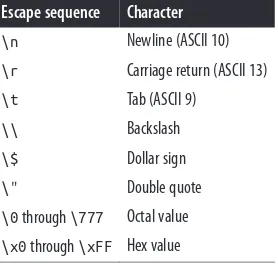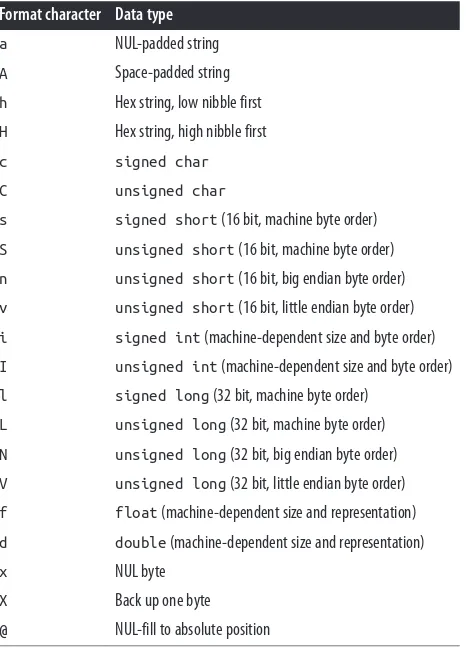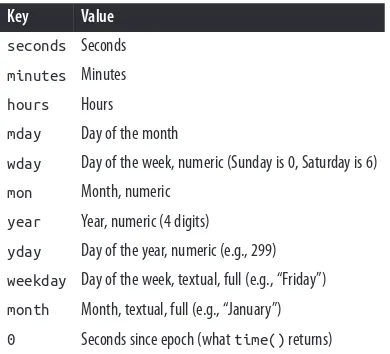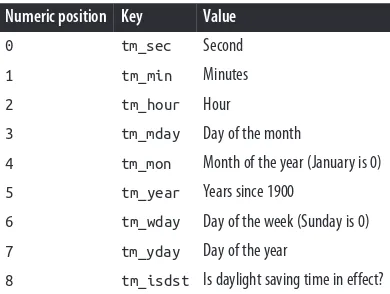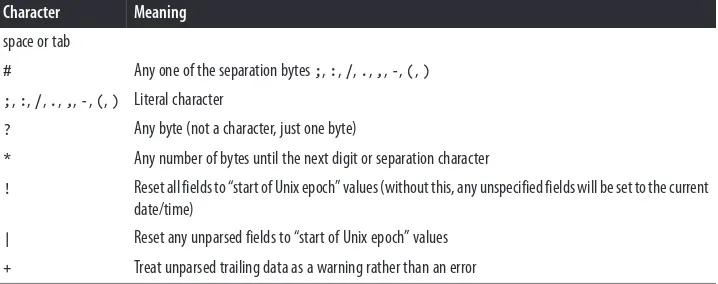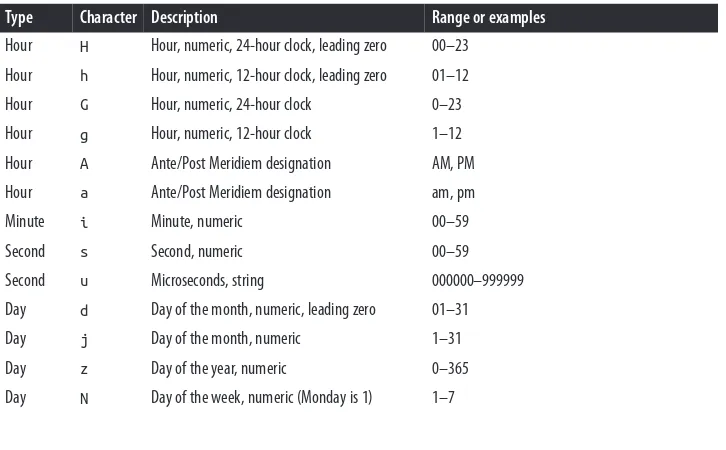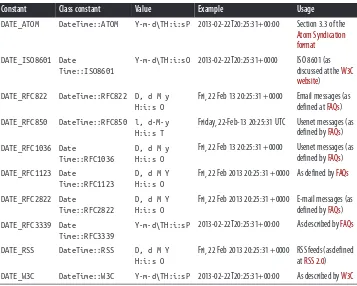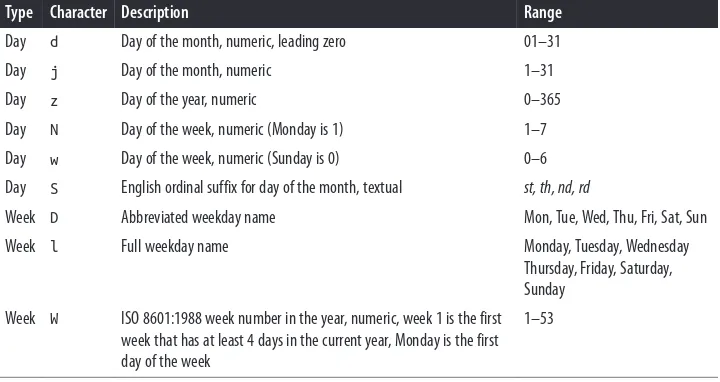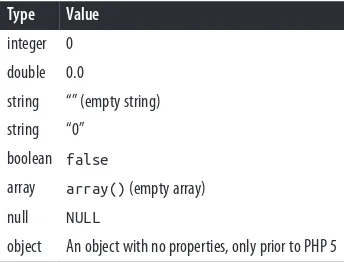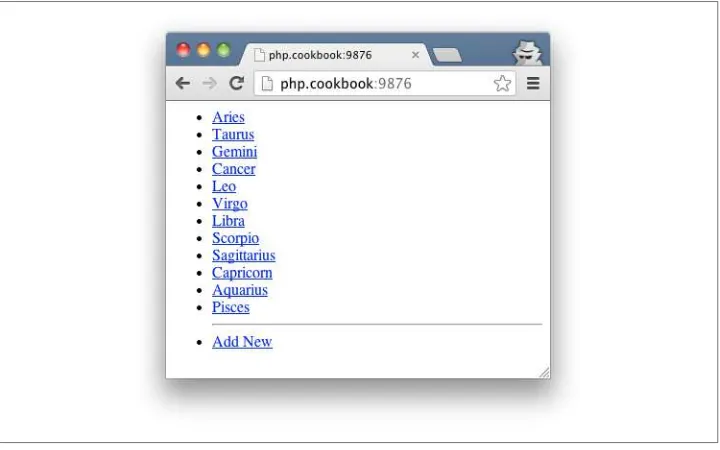PHP Cookbook, Third Edition
by David Sklar and Adam Trachtenberg
Copyright © 2014 David Sklar and Adam Trachtenberg. All rights reserved.
Printed in the United States of America.
Published by O’Reilly Media, Inc., 1005 Gravenstein Highway North, Sebastopol, CA 95472.
O’Reilly books may be purchased for educational, business, or sales promotional use. Online editions are also available for most titles (http://my.safaribooksonline.com). For more information, contact our corporate/ institutional sales department: 800-998-9938 or [email protected].
Editors: Rachel Roumeliotis and Allyson MacDonald
Production Editor: Melanie Yarbrough
Copyeditor: Kim Cofer
Proofreader: Charles Roumeliotis
Indexer: Judith McConville
Cover Designer: Karen Montgomery
Interior Designer: David Futato
Illustrator: Rebecca Demarest June 2001: First Edition
June 2004: Second Edition
June 2014: Third Edition
Revision History for the Third Edition:
2014-06-25: First release
See http://oreilly.com/catalog/errata.csp?isbn=9781449363758 for release details.
Nutshell Handbook, the Nutshell Handbook logo, and the O’Reilly logo are registered trademarks of O’Reilly Media, Inc. PHP Cookbook, the image of a Galapagos land iguana, and related trade dress are trademarks of O’Reilly Media, Inc.
Many of the designations used by manufacturers and sellers to distinguish their products are claimed as trademarks. Where those designations appear in this book, and O’Reilly Media, Inc. was aware of a trademark claim, the designations have been printed in caps or initial caps.
While every precaution has been taken in the preparation of this book, the publisher and authors assume no responsibility for errors or omissions, or for damages resulting from the use of the information contained herein.
ISBN: 978-1-449-36375-8
Table of Contents
Preface. . . xv
1. Strings. . . 1
1.1 Accessing Substrings 5
1.2 Extracting Substrings 6
1.3 Replacing Substrings 7
1.4 Processing a String One Byte at a Time 9
1.5 Reversing a String by Word or Byte 10
1.6 Generating a Random String 11
1.7 Expanding and Compressing Tabs 12
1.8 Controlling Case 14
1.9 Interpolating Functions and Expressions Within Strings 16
1.10 Trimming Blanks from a String 17
1.11 Generating Comma-Separated Data 18
1.12 Parsing Comma-Separated Data 20
1.13 Generating Fixed-Width Field Data Records 21
1.14 Parsing Fixed-Width Field Data Records 22
1.15 Taking Strings Apart 25
1.16 Wrapping Text at a Certain Line Length 27
1.17 Storing Binary Data in Strings 28
1.18 Program: Downloadable CSV File 31
2. Numbers. . . 35
2.1 Checking Whether a Variable Contains a Valid Number 36
2.2 Comparing Floating-Point Numbers 37
2.3 Rounding Floating-Point Numbers 38
2.4 Operating on a Series of Integers 40
2.5 Generating Random Numbers Within a Range 42
2.6 Generating Predictable Random Numbers 43
2.7 Generating Biased Random Numbers 44
2.8 Taking Logarithms 46
2.9 Calculating Exponents 46
2.10 Formatting Numbers 47
2.11 Formatting Monetary Values 49
2.12 Printing Correct Plurals 50
2.13 Calculating Trigonometric Functions 51
2.14 Doing Trigonometry in Degrees, Not Radians 52
2.15 Handling Very Large or Very Small Numbers 53
2.16 Converting Between Bases 55
2.17 Calculating Using Numbers in Bases Other Than Decimal 56
2.18 Finding the Distance Between Two Places 58
3. Dates and Times. . . 61
3.1 Finding the Current Date and Time 63
3.2 Converting Time and Date Parts to an Epoch Timestamp 66
3.3 Converting an Epoch Timestamp to Time and Date Parts 68
3.4 Printing a Date or Time in a Specified Format 69
3.5 Finding the Difference of Two Dates 71
3.6 Finding the Day in a Week, Month, or Year 73
3.7 Validating a Date 75
3.8 Parsing Dates and Times from Strings 77
3.9 Adding to or Subtracting from a Date 79
3.10 Calculating Time with Time Zones and Daylight Saving Time 80
3.11 Generating a High-Precision Time 82
3.12 Generating Time Ranges 83
3.13 Using Non-Gregorian Calendars 84
3.14 Program: Calendar 87
4. Arrays. . . 93
4.1 Specifying an Array Not Beginning at Element 0 96
4.2 Storing Multiple Elements per Key in an Array 97
4.3 Initializing an Array to a Range of Integers 99
4.4 Iterating Through an Array 99
4.5 Deleting Elements from an Array 102
4.6 Changing Array Size 104
4.7 Appending One Array to Another 106
4.8 Turning an Array into a String 108
4.9 Printing an Array with Commas 109
4.10 Checking if a Key Is in an Array 110
4.11 Checking if an Element Is in an Array 111
4.13 Finding Elements That Pass a Certain Test 114
4.14 Finding the Largest or Smallest Valued Element in an Array 115
4.15 Reversing an Array 116
4.16 Sorting an Array 116
4.17 Sorting an Array by a Computable Field 118
4.18 Sorting Multiple Arrays 120
4.19 Sorting an Array Using a Method Instead of a Function 122
4.20 Randomizing an Array 123
4.21 Removing Duplicate Elements from an Array 123
4.22 Applying a Function to Each Element in an Array 124
4.23 Finding the Union, Intersection, or Difference of Two Arrays 126
4.24 Iterating Efficiently over Large or Expensive Datasets 128
4.25 Accessing an Object Using Array Syntax 131
5. Variables. . . 135
5.1 Avoiding == Versus = Confusion 137
5.2 Establishing a Default Value 138
5.3 Exchanging Values Without Using Temporary Variables 139
5.4 Creating a Dynamic Variable Name 140
5.5 Persisting a Local Variable’s Value Across Function Invocations 141
5.6 Sharing Variables Between Processes 143
5.7 Encapsulating Complex Data Types in a String 149
5.8 Dumping Variable Contents as Strings 151
6. Functions. . . 157
6.1 Accessing Function Parameters 158
6.2 Setting Default Values for Function Parameters 159
6.3 Passing Values by Reference 161
6.4 Using Named Parameters 162
6.5 Enforcing Types of Function Arguments 163
6.6 Creating Functions That Take a Variable Number of Arguments 164
6.7 Returning Values by Reference 167
6.8 Returning More Than One Value 169
6.9 Skipping Selected Return Values 170
6.10 Returning Failure 171
6.11 Calling Variable Functions 172
6.12 Accessing a Global Variable Inside a Function 175
6.13 Creating Dynamic Functions 176
7. Classes and Objects. . . 179
7.1 Instantiating Objects 183
7.2 Defining Object Constructors 184
7.3 Defining Object Destructors 185
7.4 Implementing Access Control 186
7.5 Preventing Changes to Classes and Methods 189
7.6 Defining Object Stringification 190
7.7 Requiring Multiple Classes to Behave Similarly 191
7.8 Creating Abstract Base Classes 195
7.9 Assigning Object References 197
7.10 Cloning Objects 198
7.11 Overriding Property Accesses 201
7.12 Calling Methods on an Object Returned by Another Method 205
7.13 Aggregating Objects 206
7.14 Accessing Overridden Methods 210
7.15 Creating Methods Dynamically 212
7.16 Using Method Polymorphism 213
7.17 Defining Class Constants 215
7.18 Defining Static Properties and Methods 217
7.19 Controlling Object Serialization 220
7.20 Introspecting Objects 222
7.21 Checking If an Object Is an Instance of a Specific Class 226
7.22 Autoloading Class Files upon Object Instantiation 229
7.23 Instantiating an Object Dynamically 230
7.24 Program: whereis 231
8. Web Fundamentals. . . 235
8.1 Setting Cookies 236
8.2 Reading Cookie Values 238
8.3 Deleting Cookies 238
8.4 Building a Query String 239
8.5 Reading the POST Request Body 240
8.6 Using HTTP Basic or Digest Authentication 241
8.7 Using Cookie Authentication 245
8.8 Reading an HTTP Header 248
8.9 Writing an HTTP Header 249
8.10 Sending a Specific HTTP Status Code 250
8.11 Redirecting to a Different Location 251
8.12 Flushing Output to the Browser 252
8.13 Buffering Output to the Browser 253
8.14 Compressing Web Output 255
8.15 Reading Environment Variables 255
8.16 Setting Environment Variables 256
8.17 Communicating Within Apache 257
8.19 Program: Website Account (De)activator 259
8.20 Program: Tiny Wiki 262
8.21 Program: HTTP Range 265
9. Forms. . . 275
9.1 Processing Form Input 277
9.2 Validating Form Input: Required Fields 279
9.3 Validating Form Input: Numbers 281
9.4 Validating Form Input: Email Addresses 283
9.5 Validating Form Input: Drop-Down Menus 284
9.6 Validating Form Input: Radio Buttons 285
9.7 Validating Form Input: Checkboxes 287
9.8 Validating Form Input: Dates and Times 289
9.9 Validating Form Input: Credit Cards 290
9.10 Preventing Cross-Site Scripting 291
9.11 Processing Uploaded Files 292
9.12 Working with Multipage Forms 295
9.13 Redisplaying Forms with Inline Error Messages 296
9.14 Guarding Against Multiple Submissions of the Same Form 299
9.15 Preventing Global Variable Injection 301
9.16 Handling Remote Variables with Periods in Their Names 303
9.17 Using Form Elements with Multiple Options 304
9.18 Creating Drop-Down Menus Based on the Current Date 305
10. Database Access. . . 307
10.1 Using DBM Databases 310
10.2 Using an SQLite Database 313
10.3 Connecting to an SQL Database 315
10.4 Querying an SQL Database 316
10.5 Retrieving Rows Without a Loop 319
10.6 Modifying Data in an SQL Database 320
10.7 Repeating Queries Efficiently 321
10.8 Finding the Number of Rows Returned by a Query 324
10.9 Escaping Quotes 325
10.10 Logging Debugging Information and Errors 327
10.11 Creating Unique Identifiers 329
10.12 Building Queries Programmatically 331
10.13 Making Paginated Links for a Series of Records 336
10.14 Caching Queries and Results 339
10.15 Accessing a Database Connection Anywhere in Your Program 341
10.16 Program: Storing a Threaded Message Board 343
10.17 Using Redis 351
11. Sessions and Data Persistence. . . 353
11.1 Using Session Tracking 354
11.2 Preventing Session Hijacking 356
11.3 Preventing Session Fixation 357
11.4 Storing Sessons in Memcached 358
11.5 Storing Sessions in a Database 359
11.6 Storing Arbitrary Data in Shared Memory 362
11.7 Caching Calculated Results in Summary Tables 365
12. XML. . . 369
12.1 Generating XML as a String 372
12.2 Generating XML with DOM 373
12.3 Parsing Basic XML Documents 376
12.4 Parsing Complex XML Documents 379
12.5 Parsing Large XML Documents 381
12.6 Extracting Information Using XPath 387
12.7 Transforming XML with XSLT 390
12.8 Setting XSLT Parameters from PHP 392
12.9 Calling PHP Functions from XSLT Stylesheets 394
12.10 Validating XML Documents 398
12.11 Handling Content Encoding 400
12.12 Reading RSS and Atom Feeds 401
12.13 Writing RSS Feeds 404
12.14 Writing Atom Feeds 407
13. Web Automation. . . 413
13.1 Marking Up a Web Page 414
13.2 Cleaning Up Broken or Nonstandard HTML 416
13.3 Extracting Links from an HTML File 420
13.4 Converting Plain Text to HTML 422
13.5 Converting HTML to Plain Text 423
13.6 Removing HTML and PHP Tags 424
13.7 Responding to an Ajax Request 428
13.8 Integrating with JavaScript 429
13.9 Program: Finding Stale Links 433
13.10 Program: Finding Fresh Links 435
14. Consuming RESTful APIs. . . 439
14.1 Fetching a URL with the GET Method 440
14.3 Fetching a URL with an Arbitrary Method and POST Body 446
14.4 Fetching a URL with Cookies 448
14.5 Fetching a URL with Arbitrary Headers 450
14.6 Fetching a URL with a Timeout 451
14.7 Fetching an HTTPS URL 453
14.8 Debugging the Raw HTTP Exchange 453
14.9 Making an OAuth 1.0 Request 458
14.10 Making an OAuth 2.0 Request 460
15. Serving RESTful APIs. . . 465
15.1 Exposing and Routing to a Resource 468
15.2 Exposing Clean Resource Paths 471
15.3 Exposing a Resource for Reading 472
15.4 Creating a Resource 474
15.5 Editing a Resource 479
15.6 Deleting a Resource 481
15.7 Indicating Errors and Failures 482
15.8 Supporting Multiple Formats 484
16. Internet Services. . . 487
16.1 Sending Mail 488
16.2 Sending MIME Mail 490
16.3 Reading Mail with IMAP or POP3 491
16.4 Getting and Putting Files with FTP 495
16.5 Looking Up Addresses with LDAP 498
16.6 Using LDAP for User Authentication 499
16.7 Performing DNS Lookups 502
16.8 Checking If a Host Is Alive 504
16.9 Getting Information About a Domain Name 506
17. Graphics. . . 509
17.1 Drawing Lines, Rectangles, and Polygons 512
17.2 Drawing Arcs, Ellipses, and Circles 515
17.3 Drawing with Patterned Lines 517
17.4 Drawing Text 518
17.5 Drawing Centered Text 520
17.6 Building Dynamic Images 524
17.7 Getting and Setting a Transparent Color 526
17.8 Overlaying Watermarks 527
17.9 Creating Thumbnail Images 530
17.10 Reading EXIF Data 533
17.11 Serving Images Securely 535
17.12 Program: Generating Bar Charts from Poll Results 536
18. Security and Encryption. . . 541
18.1 Preventing Session Fixation 542
18.2 Protecting Against Form Spoofing 543
18.3 Ensuring Input Is Filtered 544
18.4 Avoiding Cross-Site Scripting 545
18.5 Eliminating SQL Injection 546
18.6 Keeping Passwords Out of Your Site Files 547
18.7 Storing Passwords 548
18.8 Dealing with Lost Passwords 551
18.9 Verifying Data with Hashes 553
18.10 Encrypting and Decrypting Data 555
18.11 Storing Encrypted Data in a File or Database 557
18.12 Sharing Encrypted Data with Another Website 560
18.13 Detecting SSL 562
18.14 Encrypting Email with GPG 563
19. Internationalization and Localization. . . 567
19.1 Determining the User’s Locale 569
19.2 Localizing Text Messages 570
19.3 Localizing Dates and Times 573
19.4 Localizing Numbers 577
19.5 Localizing Currency Values 579
19.6 Localizing Images 581
19.7 Localizing Included Files 583
19.8 Sorting in a Locale-Aware Order 584
19.9 Managing Localization Resources 584
19.10 Setting the Character Encoding of Outgoing Data 587
19.11 Setting the Character Encoding of Incoming Data 587
19.12 Manipulating UTF-8 Text 588
20. Error Handling. . . 593
20.1 Finding and Fixing Parse Errors 594
20.2 Creating Your Own Exception Classes 596
20.3 Printing a Stack Trace 599
20.4 Reading Configuration Variables 602
20.5 Setting Configuration Variables 603
20.6 Hiding Error Messages from Users 604
20.7 Tuning Error Handling 606
20.8 Using a Custom Error Handler 608
20.10 Eliminating “headers already sent” Errors 611
20.11 Logging Debugging Information 612
21. Software Engineering. . . 615
21.1 Using a Debugger Extension 615
21.2 Writing a Unit Test 619
21.3 Writing a Unit Test Suite 620
21.4 Applying a Unit Test to a Web Page 622
21.5 Setting Up a Test Environment 624
21.6 Using the Built-in Web Server 625
22. Performance Tuning. . . 629
22.1 Using an Accelerator 630
22.2 Timing Function Execution 631
22.3 Timing Program Execution by Function 632
22.4 Timing Program Execution by Statement 634
22.5 Timing Program Execution by Section 636
22.6 Profiling with a Debugger Extension 638
22.7 Stress-Testing Your Website 642
22.8 Avoiding Regular Expressions 643
23. Regular Expressions. . . 647
23.1 Switching from ereg to preg 651
23.2 Matching Words 652
23.3 Finding the nth Occurrence of a Match 654
23.4 Choosing Greedy or Nongreedy Matches 656
23.5 Finding All Lines in a File That Match a Pattern 658
23.6 Capturing Text Inside HTML Tags 659
23.7 Preventing Parentheses from Capturing Text 660
23.8 Escaping Special Characters in a Regular Expression 662
23.9 Reading Records with a Pattern Separator 663
23.10 Using a PHP Function in a Regular Expression 664
24. Files. . . 667
24.1 Creating or Opening a Local File 671
24.2 Creating a Temporary File 672
24.3 Opening a Remote File 673
24.4 Reading from Standard Input 674
24.5 Reading a File into a String 675
24.6 Counting Lines, Paragraphs, or Records in a File 676
24.7 Processing Every Word in a File 679
24.8 Picking a Random Line from a File 680
24.9 Randomizing All Lines in a File 681
24.10 Processing Variable-Length Text Fields 682
24.11 Reading Configuration Files 683
24.12 Modifying a File in Place Without a Temporary File 685
24.13 Flushing Output to a File 687
24.14 Writing to Standard Output 688
24.15 Writing to Many Filehandles Simultaneously 688
24.16 Escaping Shell Metacharacters 689
24.17 Passing Input to a Program 691
24.18 Reading Standard Output from a Program 692
24.19 Reading Standard Error from a Program 693
24.20 Locking a File 694
24.21 Reading and Writing Custom File Types 697
24.22 Reading and Writing Compressed Files 702
25. Directories. . . 705
25.1 Getting and Setting File Timestamps 708
25.2 Getting File Information 709
25.3 Changing File Permissions or Ownership 710
25.4 Splitting a Filename into Its Component Parts 711
25.5 Deleting a File 713
25.6 Copying or Moving a File 713
25.7 Processing All Files in a Directory 714
25.8 Getting a List of Filenames Matching a Pattern 715
25.9 Processing All Files in a Directory Recursively 717
25.10 Making New Directories 717
25.11 Removing a Directory and Its Contents 718
25.12 Program: Web Server Directory Listing 719
25.13 Program: Site Search 723
26. Command-Line PHP. . . 727
26.1 Parsing Program Arguments 729
26.2 Parsing Program Arguments with getopt 730
26.3 Reading from the Keyboard 732
26.4 Running PHP Code on Every Line of an Input File 734
26.5 Reading Passwords 736
26.6 Colorizing Console Output 738
26.7 Program: DOM Explorer 740
27. Packages. . . 745
27.1 Defining and Installing Composer Dependencies 748
27.3 Installing Composer Packages 751
27.4 Using the PEAR Installer 754
27.5 Finding PEAR Packages 757
27.6 Finding Information About a Package 759
27.7 Installing PEAR Packages 760
27.8 Upgrading PEAR Packages 762
27.9 Uninstalling PEAR Packages 763
27.10 Installing PECL Packages 764
Index. . . 767
Preface
PHP is the engine behind millions of dynamic web applications. Its broad feature set, approachable syntax, and support for different operating systems and web servers have made it an ideal language for both rapid web development and the methodical con‐ struction of complex systems.
One of the major reasons for PHP’s success as a web scripting language is its origins as a tool to process HTML forms and create web pages. This makes PHP very web-friendly. Additionally, it is eagerly promiscuous when it comes to external applications and li‐ braries. PHP can speak to a multitude of databases, and it knows numerous Internet protocols. PHP also makes it simple to parse form data and make HTTP requests. This web-specific focus carries over to the recipes and examples in the PHP Cookbook. This book is a collection of solutions to common tasks in PHP. We’ve tried to include material that will appeal to everyone from newbies to wizards. If we’ve succeeded, you’ll learn something (or perhaps many things) from PHP Cookbook. There are tips in here for everyday PHP programmers as well as for people coming to PHP with experience in another language.
PHP, in source code and binary forms, is available for download free from http:// www.php.net/. The PHP website also contains installation instructions, comprehensive documentation, and pointers to online resources, user groups, mailing lists, and other PHP resources.
Who This Book Is For
This book is for programmers who need to solve problems with PHP. If you don’t know any PHP, make this your second PHP book. The first should be Learning PHP 5, also from O’Reilly.
If you’re already familiar with PHP, this book helps you overcome a specific problem and get on with your life (or at least your programming activities). The PHP Cook‐
book can also show you how to accomplish a particular task in PHP, such as sending email or parsing JSON, that you may already know how to do in another language. Programmers converting applications from other languages to PHP will find this book a trusty companion.
What Is in This Book
We don’t expect that you’ll sit down and read this book from cover to cover (although we’ll be happy if you do!). PHP programmers are constantly faced with a wide variety of challenges on a wide range of subjects. Turn to the PHP Cookbook when you en‐ counter a problem you need to solve. Each recipe is a self-contained explanation that gives you a head start toward finishing your task. When a recipe refers to topics outside its scope, it contains pointers to related recipes and other online and offline resources. If you choose to read an entire chapter at once, that’s OK. The recipes generally flow from easy to hard, with example programs that “put it all together” at the end of many chapters. The chapter introduction provides an overview of the material covered in the chapter, including relevant background material, and points out a few highlighted rec‐ ipes of special interest.
The book begins with four chapters about basic data types. Chapter 1 covers details like processing substrings, manipulating case, taking strings apart into smaller pieces, and parsing comma-separated data. Chapter 2 explains operations with floating-point num‐ bers, random numbers, converting between bases, and number formatting. Chapter 3 shows you how to manipulate dates and times, format them, handle time zones and daylight saving time, and find time to microsecond precision. Chapter 4 covers array operations like iterating, merging, reversing, sorting, and extracting particular elements. Next are three chapters that discuss program building blocks. Chapter 5 covers notable features of PHP’s variable handling, such as default values, static variables, and pro‐ ducing string representations of complex data types. The recipes in Chapter 6 deal with using functions in PHP: processing arguments, passing and returning variables by ref‐ erence, creating functions at runtime, and scoping variables. Chapter 7 covers PHP’s object-oriented capabilities, with recipes on OOP basics as well as more advanced fea‐ tures, such as magic methods, destructors, access control, reflection, traits, and name‐ spaces.
connect to a database, assign unique ID values, retrieve rows, change data, escape quotes, and log debugging information. Chapter 11 covers PHP’s built-in sessions module, which lets you maintain information about a user as he moves from page to page on your website. This chapter also highlights some of the security issues associated with sessions. Chapter 12 discusses all things XML: the SimpleXML extension and DOM functions, using XPath and XSLT, and reading and writing both RSS and Atom feeds. Chapter 13 explores topics useful to PHP applications that integrate with external web‐ sites and client-side JavaScript such as retrieving remote URLs, cleaning up HTML, and responding to an Ajax request.
The next three chapters are all about network interaction. Chapter 14 details the ins and outs of consuming a web service—using an external REST service from within your code. Chapter 15 handles the other side of the web services equation—serving up REST requests to others. Both chapters discuss authentication, headers, and error handling. Chapter 16 discusses other network services such as sending email messages, using LDAP, and doing DNS lookups.
The next section of the book is a series of chapters on features and extensions of PHP that help you build applications that are robust, secure, user-friendly, and efficient. Chapter 17 shows you how to create graphics, with recipes on drawing text, lines, polygons, and curves. Chapter 18 focuses on security topics such as avoiding session fixation and cross-site scripting, working with passwords, and encrypting data. Chap‐ ter 19 helps you make your applications globally friendly and includes recipes for lo‐ calizing text, dates and times, currency values, and images, as well as a recipe working with text in UTF-8 character encoding. Chapter 20 goes into detail on error handling and logging, while Chapter 21 discusses debugging techniques, writing tests for your code, and using PHP’s built-in web server. Chapter 22 explains how to compare the performance of two functions and provides tips on getting your programs to run at maximum speed. Chapter 23 covers regular expressions, including capturing text inside of HTML tags, calling a PHP function from inside a regular expression, and using greedy and nongreedy matching.
Chapters 24 and 25 cover the filesystem. Chapter 24 focuses on files: opening and closing them, using temporary files, locking files, sending compressed files, and processing the contents of files. Chapter 25 deals with directories and file metadata, with recipes on changing file permissions and ownership, moving or deleting a file, and processing all files in a directory.
Last, there are two chapters on topics that extend the reach of what PHP can do. Chap‐ ter 26 covers using PHP outside of web programming. Its recipes cover command-line topics such as parsing program arguments and reading passwords. Chapter 27 covers Composer, PEAR (PHP Extension and Application Repository), and PECL (PHP Ex‐ tension Community Library). Composer and PEAR provide access to a collection of PHP code that provides functions and extensions to PHP. PECL is a similar collection,
but of extensions to PHP written in C. We use PEAR and PECL modules throughout the book and Chapter 27 shows you how to install and upgrade them.
Other Resources
Websites
There is a tremendous amount of PHP reference material online. With everything from the annotated PHP manual to sites with periodic articles and tutorials, a fast Internet connection rivals a large bookshelf in PHP documentary usefulness. Here are some key sites:
The Annotated PHP Manual
Available in 11 languages, this site includes both official documentation of functions and language features as well as user-contributed comments.
PHP mailing lists
There are many PHP mailing lists covering installation, programming, extending PHP, and various other topics; there is also a read-only web interface to the mailing lists.
PHP support resources
This handy collection of support resources has information on PHP user groups, events, and other support channels.
Composer
Composer is a dependency manager for PHP that provides a structured way both to declare dependencies in your project and to install them.
PEAR
PEAR calls itself “a framework and distribution system for reusable PHP compo‐ nents.” You’ll find lots of useful PHP classes and sample code there. Read more about PEAR in Chapter 27.
PECL
PECL calls itself “a repository for PHP Extensions, providing a directory of exten‐ sions and hosting facilities for downloading and development of PHP extensions.” Read more about PECL in Chapter 27.
PHP.net: A Tourist’s Guide
This is a guide to the various websites under the php.net umbrella. PHP: The Right Way
Planet PHP
An aggregation of blog posts by PHP developers, about PHP. SitePoint Blogs on PHP
A good collection of information that explores PHP.
Books
This section lists books that are helpful references and tutorials for building applications with PHP. Most are specific to web-related programming; look for books on MySQL, HTML, XML, and HTTP.
At the end of the section, we’ve included a few books that are useful for every program‐ mer regardless of language of choice. These works can make you a better programmer by teaching you how to think about programming as part of a larger pattern of problem solving:
• Learning PHP 5 by David Sklar (O’Reilly)
• Programming PHP by Rasmus Lerdorf, Kevin Tatroe, and Peter MacIntyre (O’Reil‐ ly)
• Extending and Embedding PHP by Sara Golemon (Sams)
• Learning PHP, MySQL, JavaScript, and CSS by Robin Nixon (O’Reilly) • Mastering Regular Expressions by Jeffrey E. F. Friedl (O’Reilly)
• MySQL Reference Manual
• MySQL, by Paul DuBois (New Riders)
• The Practice of Programming, by Brian W. Kernighan and Rob Pike (Addison-Wesley)
• Programming Pearls by Jon Louis Bentley (Addison-Wesley)
• The Mythical Man-Month, by Frederick P. Brooks (Addison-Wesley)
Conventions Used in This Book
Programming Conventions
The examples in this book were written to run under PHP version 5.4.28 (and, where applicable, PHP 5.5.12). Sample code should work on both Unix and Windows, except where noted in the text. We’ve generally noted in the text when we depend on a feature added to PHP in or after 5.5.
Some examples rely on the $php_errormsg variable, which is only available when the
track_errors configuration directive is turned on.
Typesetting Conventions
The following typographic conventions are used in this book: Italic
Used for commands, filenames, and example URLs. It is also used to define new terms when they first appear in the text.
Constant width
Used in code examples to show partial or complete PHP source code program listings. It is also used for class names, method names, variable names, and other fragments of PHP code.
Constant width bold
Used for user input, such as commands that you type on the command line. Constant width italic
Shows text that should be replaced with user-supplied values or by values deter‐ mined by context.
Comments and Questions
Please address comments and questions concerning this book to the publisher:
O’Reilly Media, Inc.
1005 Gravenstein Highway North Sebastopol, CA 95472
800-998-9938 (in the United States or Canada) 707-829-0515 (international or local)
707-829-0104 (fax)
We have a web page for this book, where we list errata, examples, and any additional information. You can access this page at http://bit.ly/phpckbk3.
To comment or ask technical questions about this book, send email to bookques [email protected].
For more information about our books, courses, conferences, and news, see our website at http://www.oreilly.com.
Acknowledgments
Most importantly, a huge thanks to everyone who has contributed their time, creativity, and skills to making PHP what it is today. This amazing volunteer effort has created not only hundreds of thousands of lines of source code, but also comprehensive documen‐ tation, a QA infrastructure, lots of add-on applications and libraries, and a thriving user community worldwide. It’s a thrill and an honor to add the PHP Cookbook to the world of PHP.
Thanks also to our reviewers: Paul Huff, Peter MacIntyre, Simon MacIntyre, and Russ Uman. Special mention to Chris Shiflett and Clay Lovelace for their contributions to the second edition of this book.
And big thanks to the folks at O’Reilly that made this book a reality: Rachel Roumeliotis, Allyson MacDonald, Melanie Yarbrough, and Maria Gulick as well as the nameless orcs and dwarves that toil in the subterranean caverns of Sebastopol and Cambridge to make sure that the production process runs smoothly.
David Sklar
Thanks twice again to Adam. We’ve been working together (in one way or another) for 18 years and PHPing together for 17. There is still no one with whom I’d rather have written this book (except, to be completely honest, maybe Ben Franklin, if he could somehow be brought back to life).
Thanks to my family members of all ages. You gave me the time and space to focus on the book. Now I will give you time and space to read the entire thing!
Adam Trachtenberg
David: It’s tough to complete with Ben Franklin. Please know that I support the turkey as the official animal of PHP instead of the elephant. Many thanks for your support over all these years, beginning long ago in the days of PHP/FI. Without you, this book would merely be a dream.
Thanks to my family and friends for their support and encouragement over these many months. All my love to my two sons, even the one who helped me relearn that human children don’t give you extensions after 40 weeks if your work on PHP Cookbook isn’t complete. Finally, special thanks to my wife Elizabeth Anne; I should take your good advice more often.
CHAPTER 1
Strings
1.0 Introduction
Strings in PHP are sequences of bytes, such as “We hold these truths to be self-evident” or “Once upon a time” or even “111211211.” When you read data from a file or output it to a web browser, your data is represented as strings.
PHP strings are binary-safe (i.e., they can contain null bytes) and can grow and shrink on demand. Their size is limited only by the amount of memory that is available to PHP.
Usually, PHP strings are ASCII strings. You must do extra work to handle non-ASCII data like UTF-8 or other multibyte character en‐ codings (see Chapter 19).
Similar in form and behavior to Perl and the Unix shell, strings can be initialized in three ways: with single quotes, with double quotes, and with the “here document” (heredoc) format. With single-quoted strings, the only special characters you need to escape inside a string are the backslash and the single quote itself. This example shows four single-quoted strings:
print 'I have gone to the store.'; print 'I\'ve gone to the store.';
print 'Would you pay $1.75 for 8 ounces of tap water?';
print 'In double-quoted strings, newline is represented by \n'; It prints:
I have gone to the store. I've gone to the store.
Would you pay $1.75 for 8 ounces of tap water?
In double-quoted strings, newline is represented by \n
The preceding output shows what the raw output looks like. If you view it in a web browser, you will see all the sentences on the same line because HTML requires additional markup to insert line breaks.
Because PHP doesn’t check for variable interpolation or almost any escape sequences in single-quoted strings, defining strings this way is straightforward and fast.
Double-quoted strings don’t recognize escaped single quotes, but they do recognize interpolated variables and the escape sequences shown in Table 1-1.
Table 1-1. Double-quoted string escape sequences
Escape sequence Character \n Newline (ASCII 10) \r Carriage return (ASCII 13) \t Tab (ASCII 9)
\\ Backslash
\$ Dollar sign
\" Double quote
\0 through \777 Octal value \x0 through \xFF Hex value
Example 1-1 shows some double-quoted strings. Example 1-1. Double-quoted strings
print "I've gone to the store."; print "The sauce cost \$10.25."; $cost = '$10.25';
print "The sauce cost $cost.";
print "The sauce cost \$\061\060.\x32\x35."; Example 1-1 prints:
I've gone to the store. The sauce cost $10.25. The sauce cost $10.25. The sauce cost $10.25.
The last line of Example 1-1 prints the price of sauce correctly because the character 1
is ASCII code 49 decimal and 061 octal. Character 0 is ASCII 48 decimal and 060 octal;
2 is ASCII 50 decimal and 32 hex; and 5 is ASCII 53 decimal and 35 hex.
a token. That token (with no leading or trailing whitespace), followed by a semicolon to end the statement (if necessary), ends the heredoc. Example 1-2 shows how to define a heredoc.
Example 1-2. Defining a here document print <<< END
It's funny whensigns say things like: Original "Root" Beer
"Free" Gift
Shoes cleaned while "you" wait or haveother misquoted words. END;
Example 1-2 prints:
It's funny when signs say things like: Original "Root" Beer
"Free" Gift
Shoes cleaned while "you" wait or have other misquoted words.
Newlines, spacing, and quotes are all preserved in a heredoc. By convention, the end-of-string identifier is usually all caps, and it is case sensitive. Example 1-3 shows two more valid heredocs. DOGS AND CATS ARE GREAT! DOGS;
Heredocs are especially useful for printing out HTML with interpolated variables be‐ cause you don’t have to escape the double quotes that appear in the HTML elements. Example 1-4 uses a heredoc to print HTML.
print <<< HTML
There are <b>$remaining_cards</b> left. <p>
<a href="$url">$text</a> HTML;
In Example 1-4, the semicolon needs to go after the end-of-string delimiter to tell PHP the statement is ended. In some cases, however, you shouldn’t use the semicolon. One of these cases is shown in Example 1-5, which uses a heredoc with the string concate‐ nation operator.
Example 1-5. Concatenation with a here document $html = <<< END
<div class="$divClass"> <ul class="$ulClass"> <li>
END
. $listItem . '</li></div>'; print $html;
Assuming some reasonable values for the $divClass, $ulClass, and $listItem vari‐ ables, Example 1-5 prints:
<div class="class1">> <ul class="class2">
<li> The List Item </li></div>
In Example 1-5, the expression needs to continue on the next line, so you don’t use a semicolon. Note also that in order for PHP to recognize the end-of-string delimiter, the . string concatenation operator needs to go on a separate line from the end-of-string delimiter.
Nowdocs are similar to heredocs, but there is no variable interpolation. So, nowdocs are to heredocs as single-quoted strings are to double-quoted strings. They’re best when you have a block of non-PHP code, such as JavaScript, that you want to print as part of an HTML page or send to another program.
For example, if you’re using jQuery: $js = <<<'__JS__'
$.ajax({
'url': '/api/getStock', 'data': {
'ticker': 'LNKD' },
'success': function( data ) {
$( "#stock-price" ).html( "<strong>$" + data + "</strong>" ); }
__JS__;
print $js;
Individual bytes in strings can be referenced with square brackets. The first byte in the string is at index 0. Example 1-6 grabs one byte from a string.
Example 1-6. Getting an individual byte in a string $neighbor = 'Hilda';
print $neighbor[3]; Example 1-6 prints:
d
1.1 Accessing Substrings
Problem
You want to know if a string contains a particular substring. For example, you want to find out if an email address contains a @.
Solution
Use strpos(), as in Example 1-7.
Example 1-7. Finding a substring with strpos( ) if (strpos($_POST['email'], '@') === false) { print 'There was no @ in the e-mail address!'; }
Discussion
The return value from strpos() is the first position in the string (the “haystack”) at which the substring (the “needle”) was found. If the needle wasn’t found at all in the haystack, strpos() returns false. If the needle is at the beginning of the haystack,
strpos() returns 0 because position 0 represents the beginning of the string. To dif‐ ferentiate between return values of 0 and false, you must use the identity operator (===) or the not–identity operator (!==) instead of regular equals (==) or not-equals (!=). Example 1-7 compares the return value from strpos() to false using ===. This test only succeeds if strpos() returns false, not if it returns 0 or any other number.
See Also
Documentation on strpos().
1.2 Extracting Substrings
Problem
You want to extract part of a string, starting at a particular place in the string. For example, you want the first eight characters of a username entered into a form.
Solution
Use substr() to select your substring, as in Example 1-8. Example 1-8. Extracting a substring with substr( )
$substring = substr($string,$start,$length);
$username = substr($_GET['username'],0,8);
Discussion
If $start and $length are positive, substr() returns $length characters in the string, starting at $start. The first character in the string is at position 0. Example 1-9 has positive $start and $length.
Example 1-9. Using substr( ) with positive $start and $length print substr('watch out for that tree',6,5);
Example 1-9 prints: out f
If you leave out $length, substr() returns the string from $start to the end of the original string, as shown in Example 1-10.
Example 1-10. Using substr( ) with positive start and no length print substr('watch out for that tree',17);
Example 1-10 prints: t tree
If $start is bigger than the length of the string, substr() returns false.
If $start plus $length goes past the end of the string, substr() returns all of the string from $start forward, as shown in Example 1-11.
Example 1-11. Using substr( ) with length past the end of the string print substr('watch out for that tree',20,5);
ree
If $start is negative, substr() counts back from the end of the string to determine where your substring starts, as shown in Example 1-12.
Example 1-12. Using substr( ) with negative start print substr('watch out for that tree',-6); print substr('watch out for that tree',-17,5); Example 1-12 prints:
t tree out f
With a negative $start value that goes past the beginning of the string (for example, if
$start is −27 with a 20-character string), substr() behaves as if $start is 0.
If $length is negative, substr() counts back from the end of the string to determine where your substring ends, as shown in Example 1-13.
Example 1-13. Using substr( ) with negative length print substr('watch out for that tree',15,-2); print substr('watch out for that tree',-4,-1); Example 1-13 prints:
hat tr tre
See Also
Documentation on substr().
1.3 Replacing Substrings
Problem
You want to replace a substring with a different string. For example, you want to obscure all but the last four digits of a credit card number before printing it.
Solution
Use substr_replace(), as in Example 1-14.
Example 1-14. Replacing a substring with substr_replace( ) // Everything from position $start to the end of $old_string // becomes $new_substring
$new_string = substr_replace($old_string,$new_substring,$start);
// $length characters, starting at position $start, become $new_substring
$new_string = substr_replace($old_string,$new_substring,$start,$length);
Discussion
Without the $length argument, substr_replace() replaces everything from $start
to the end of the string. If $length is specified, only that many characters are replaced: print substr_replace('My pet is a blue dog.','fish.',12);
print substr_replace('My pet is a blue dog.','green',12,4);
$credit_card = '4111 1111 1111 1111';
print substr_replace($credit_card,'xxxx ',0,strlen($credit_card)-4);
My pet is a fish. My pet is a green dog. xxxx 1111
If $start is negative, the new substring is placed by counting $start characters from the end of $old_string, not from the beginning:
print substr_replace('My pet is a blue dog.','fish.',-9); print substr_replace('My pet is a blue dog.','green',-9,4);
My pet is a fish. My pet is a green dog.
If $start and $length are 0, the new substring is inserted at the start of $old_string: print substr_replace('My pet is a blue dog.','Title: ',0,0);
Title: My pet is a blue dog.
The function substr_replace() is useful when you’ve got text that’s too big to display all at once, and you want to display some of the text with a link to the rest. Example 1-15 displays the first 25 characters of a message with an ellipsis after it as a link to a page that displays more text.
Example 1-15. Displaying long text with an ellipsis
$r = mysql_query("SELECT id,message FROM messages WHERE id = $id") or die(); $ob = mysql_fetch_object($r);
printf('<a href="more-text.php?id=%d">%s</a>',
$ob->id, substr_replace($ob->message,' ...',25));
The more-text.php page referenced in Example 1-15 can use the message ID passed in the query string to retrieve the full message and display it.
See Also
1.4 Processing a String One Byte at a Time
Problem
You need to process each byte in a string individually.
Solution
Loop through each byte in the string with for. Example 1-16 counts the vowels in a string.
Example 1-16. Processing each byte in a string
$string = "This weekend, I'm going shopping for a pet chicken."; $vowels = 0;
for ($i = 0, $j = strlen($string); $i < $j; $i++) { if (strstr('aeiouAEIOU',$string[$i])) {
$vowels++; }
}
Discussion
Processing a string a character at a time is an easy way to calculate the “Look and Say” sequence, as shown in Example 1-17.
Example 1-17. The Look and Say sequence function lookandsay($s) {
// initialize the return value to the empty string $r = '';
// $m holds the character we're counting, initialize to the first // character in the string
$m = $s[0];
// $n is the number of $m's we've seen, initialize to 1 $n = 1;
for ($i = 1, $j = strlen($s); $i < $j; $i++) { // if this character is the same as the last one if ($s[$i] == $m) {
// increment the count of this character $n++;
} else {
// otherwise, add the count and character to the return value $r .= $n.$m;
// set the character we're looking for to the current one $m = $s[$i];
// and reset the count to 1 $n = 1;
} }
// return the built up string as well as the last count and character
return $r.$n.$m; }
for ($i = 0, $s = 1; $i < 10; $i++) { $s = lookandsay($s);
print "$s\n"; }
Example 1-17 prints: 1
11 21 1211 111221 312211 13112221 1113213211 31131211131221 13211311123113112211
It’s called the “Look and Say” sequence because each element is what you get by looking at the previous element and saying what’s in it. For example, looking at the first element, 1, you say “one one.” So the second element is “11.” That’s two ones, so the third element is “21.” Similarly, that’s one two and one one, so the fourth element is “1211,” and so on.
See Also
Documentation on for; more about the “Look and Say” sequence.
1.5 Reversing a String by Word or Byte
Problem
You want to reverse the words or the bytes in a string.
Solution
Use strrev() to reverse by byte, as in Example 1-18. Example 1-18. Reversing a string by byte
print strrev('This is not a palindrome.'); Example 1-18 prints:
.emordnilap a ton si sihT
Example 1-19. Reversing a string by word $s = "Once upon a time there was a turtle."; // break the string up into words
$words = explode(' ',$s); // reverse the array of words
$words = array_reverse($words);
// rebuild the string $s = implode(' ',$words); print $s;
Example 1-19 prints:
turtle. a was there time a upon Once
Discussion
Reversing a string by words can also be done all in one line with the code in Example 1-20.
Example 1-20. Concisely reversing a string by word
$reversed_s = implode(' ',array_reverse(explode(' ',$s)));
See Also
Recipe 24.7 discusses the implications of using something other than a space character as your word boundary; documentation on strrev() and array_reverse().
1.6 Generating a Random String
Problem
You want to generate a random string.
Solution
Use str_rand():
function str_rand($length = 32, $characters = ↵
'0123456789abcdefghijklmnopqrstuvwxyzABCDEFGHIJKLMNOPQRSTUVWXYZ') {
if (!is_int($length) || $length < 0) { return false;
}
$characters_length = strlen($characters) - 1; $string = '';
for ($i = $length; $i > 0; $i--) {
$string .= $characters[mt_rand(0, $characters_length)];
}
return $string; }
Discussion
PHP has native functions for generating random numbers, but nothing for random strings. The str_rand() function returns a 32-character string constructed from letters and numbers.
Pass in an integer to change the length of the returned string. To use an alternative set of characters, pass them as a string as the second argument. For example, to get a 16-digit Morse Code:
print str_rand(16, '.-');
.--..-.-.--.----See Also
Recipe 2.5 for generating random numbers.
1.7 Expanding and Compressing Tabs
Problem
You want to change spaces to tabs (or tabs to spaces) in a string while keeping text aligned with tab stops. For example, you want to display formatted text to users in a standardized way.
Solution
Use str_replace() to switch spaces to tabs or tabs to spaces, as shown in Example 1-21. Example 1-21. Switching tabs and spaces
$rows = $db->query('SELECT message FROM messages WHERE id = 1'); $obj = $rows->fetch(PDO::FETCH_OBJ);
$tabbed = str_replace(' ' , "\t", $obj->message); $spaced = str_replace("\t", ' ' , $obj->message); print "With Tabs: <pre>$tabbed</pre>";
Using str_replace() for conversion, however, doesn’t respect tab stops. If you want tab stops every eight characters, a line beginning with a five-letter word and a tab should have that tab replaced with three spaces, not one. Use the tab_expand() function shown in Example 1-22 to turn tabs to spaces in a way that respects tab stops.
Example 1-22. tab_expand( )
$spaced = tab_expand($obj->message);
You can use the tab_unexpand() function shown in Example 1-23 to turn spaces back to tabs.
return implode("\n",$lines); }
$tabbed = tab_unexpand($obj->message);
Both functions take a string as an argument and return the string appropriately modi‐ fied.
Discussion
Each function assumes tab stops are every eight spaces, but that can be modified by changing the setting of the $tab_stop variable.
The regular expression in tab_expand() matches both a group of tabs and all the text in a line before that group of tabs. It needs to match the text before the tabs because the length of that text affects how many spaces the tabs should be replaced with so that subsequent text is aligned with the next tab stop. The function doesn’t just replace each tab with eight spaces; it adjusts text after tabs to line up with tab stops.
Similarly, tab_unexpand() doesn’t just look for eight consecutive spaces and then re‐ place them with one tab character. It divides up each line into eight-character chunks and then substitutes ending whitespace in those chunks (at least two spaces) with tabs. This not only preserves text alignment with tab stops; it also saves space in the string.
See Also
Documentation on str_replace(), on preg_replace_callback(), and on str_split(). Recipe 23.10 has more information on preg_replace_callback().
1.8 Controlling Case
Problem
You need to capitalize, lowercase, or otherwise modify the case of letters in a string. For example, you want to capitalize the initial letters of names but lowercase the rest.
Solution
Use ucfirst() or ucwords() to capitalize the first letter of one or more words, as shown in Example 1-24.
Example 1-24. Capitalizing letters
Example 1-24 prints: How do you do today? The Prince Of Wales
Use strtolower() or strtoupper() to modify the case of entire strings, as in Example 1-25.
Example 1-25. Changing case of strings print strtoupper("i'm not yelling!");
print strtolower('<A HREF="one.php">one</A>'); Example 1-25 prints:
I'M NOT YELLING!
<a href="one.php">one</a>
Discussion
Use ucfirst() to capitalize the first character in a string: print ucfirst('monkey face');
print ucfirst('1 monkey face'); This prints:
Monkey face 1 monkey face
Note that the second phrase is not “1 Monkey face.”
Use ucwords() to capitalize the first character of each word in a string: print ucwords('1 monkey face');
print ucwords("don't play zone defense against the philadelphia 76-ers"); This prints:
1 Monkey Face
Don't Play Zone Defense Against The Philadelphia 76-ers
As expected, ucwords() doesn’t capitalize the “t” in “don’t.” But it also doesn’t capitalize the “e” in “76-ers.” For ucwords(), a word is any sequence of nonwhitespace characters that follows one or more whitespace characters. Because both ' and - aren’t whitespace characters, ucwords() doesn’t consider the “t” in “don’t” or the “e” in “76-ers” to be word-starting characters.
Both ucfirst() and ucwords() don’t change the case of non–first letters: print ucfirst('macWorld says I should get an iBook');
print ucwords('eTunaFish.com might buy itunaFish.Com!'); This prints:
MacWorld says I should get an iBook ETunaFish.com Might Buy ItunaFish.Com!
The functions strtolower() and strtoupper() work on entire strings, not just indi‐ vidual characters. All alphabetic characters are changed to lowercase by strtolow er() and strtoupper() changes all alphabetic characters to uppercase:
print strtolower("I programmed the WOPR and the TRS-80.");
print strtoupper('"since feeling is first" is a poem by e. e. cummings.'); This prints:
i programmed the wopr and the trs-80.
"SINCE FEELING IS FIRST" IS A POEM BY E. E. CUMMINGS.
When determining upper- and lowercase, these functions respect your locale settings.
See Also
For more information about locale settings, see Chapter 19; documentation on uc first(), ucwords(), strtolower(), and strtoupper().
1.9 Interpolating Functions and Expressions Within
Strings
Problem
You want to include the results of executing a function or expression within a string.
Solution
Use the string concatenation operator (.), as shown in Example 1-26, when the value you want to include can’t be inside the string.
Example 1-26. String concatenation
print 'You have '.($_POST['boys'] + $_POST['girls']).' children.'; print "The word '$word' is ".strlen($word).' characters long.'; print 'You owe '.$amounts['payment'].' immediately.';
print "My circle's diameter is ".$circle->getDiameter().' inches.';
Discussion
You can put variables, object properties, and array elements (if the subscript is unquo‐ ted) directly in double-quoted strings:
print "I have $children children.";
print "You owe $amounts[payment] immediately.";
Interpolation with double-quoted strings places some limitations on the syntax of what can be interpolated. In the previous example, $amounts['payment'] had to be written as $amounts[payment] so it would be interpolated properly. Use curly braces around more complicated expressions to interpolate them into a string. For example:
print "I have {$children} children.";
print "You owe {$amounts['payment']} immediately.";
print "My circle's diameter is {$circle->getDiameter()} inches.";
Direct interpolation or using string concatenation also works with heredocs. Interpo‐ lating with string concatenation in heredocs can look a little strange because the closing heredoc delimiter and the string concatenation operator have to be on separate lines:
print <<< END
Right now, the time is END
. strftime('%c') . <<< END but tomorrow it will be END
. strftime('%c',time() + 86400);
Also, if you’re interpolating with heredocs, make sure to include appropriate spacing for the whole string to appear properly. In the previous example, Right now, the time is has to include a trailing space, and but tomorrow it will be has to include leading and trailing spaces.
See Also
For the syntax to interpolate variable variables (such as ${"amount_$i"}), see Recipe 5.4; documentation on the string concatenation operator.
1.10 Trimming Blanks from a String
Problem
You want to remove whitespace from the beginning or end of a string. For example, you want to clean up user input before validating it.
Solution
Use ltrim(), rtrim(), or trim(). The ltrim() function removes whitespace from the beginning of a string, rtrim() from the end of a string, and trim() from both the beginning and end of a string:
$zipcode = trim($_GET['zipcode']); $no_linefeed = rtrim($_GET['text']); $name = ltrim($_GET['name']);
Discussion
For these functions, whitespace is defined as the following characters: newline, carriage return, space, horizontal and vertical tab, and null.
Trimming whitespace off of strings saves storage space and can make for more precise display of formatted data or text within <pre> tags, for example. If you are doing com‐ parisons with user input, you should trim the data first, so that someone who mistakenly enters 98052 followed by a few spaces as their zip code isn’t forced to fix an error that really isn’t one. Trimming before exact text comparisons also ensures that, for example, “salami\n” equals “salami.” It’s also a good idea to normalize string data by trimming it before storing it in a database.
The trim() functions can also remove user-specified characters from strings. Pass the characters you want to remove as a second argument. You can indicate a range of char‐ acters with two dots between the first and last characters in the range:
// Remove numerals and space from the beginning of the line print ltrim('10 PRINT A$',' 0..9');
// Remove semicolon from the end of the line print rtrim('SELECT * FROM turtles;',';'); This prints:
PRINT A$
SELECT * FROM turtles
PHP also provides chop() as an alias for rtrim(). However, you’re best off using
rtrim() instead because PHP’s chop() behaves differently than Perl’s chop() (which is deprecated in favor of chomp(), anyway), and using it can confuse others when they read your code.
See Also
Documentation on trim(), ltrim(), and rtrim().
1.11 Generating Comma-Separated Data
Problem
You want to format data as comma-separated values (CSV) so that it can be imported by a spreadsheet or database.
Solution
Use the fputcsv() function to generate a CSV-formatted line from an array of data.
Example 1-27. Generating comma-separated data
$sales = array( array('Northeast','2005-01-01','2005-02-01',12.54), array('Northwest','2005-01-01','2005-02-01',546.33), array('Southeast','2005-01-01','2005-02-01',93.26), array('Southwest','2005-01-01','2005-02-01',945.21), array('All Regions','--','--',1597.34) );
$filename = './sales.csv';
$fh = fopen($filename,'w') or die("Can't open $filename"); foreach ($sales as $sales_line) {
if (fputcsv($fh, $sales_line) === false) { die("Can't write CSV line");
} }
fclose($fh) or die("Can't close $filename");
Discussion
To print the CSV-formatted data instead of writing it to a file, use the special output stream php://output, as shown in Example 1-28.
Example 1-28. Printing comma-separated data
$sales = array( array('Northeast','2005-01-01','2005-02-01',12.54), array('Northwest','2005-01-01','2005-02-01',546.33), array('Southeast','2005-01-01','2005-02-01',93.26), array('Southwest','2005-01-01','2005-02-01',945.21), array('All Regions','--','--',1597.34) );
$fh = fopen('php://output','w'); foreach ($sales as $sales_line) {
if (fputcsv($fh, $sales_line) === false) { die("Can't write CSV line");
} }
fclose($fh);
To put the CSV-formatted data into a string instead of printing it or writing it to a file, combine the technique in Example 1-28 with output buffering, as shown in Example 1-29.
Example 1-29. Putting comma-separated data into a string
$sales = array( array('Northeast','2005-01-01','2005-02-01',12.54), array('Northwest','2005-01-01','2005-02-01',546.33), array('Southeast','2005-01-01','2005-02-01',93.26), array('Southwest','2005-01-01','2005-02-01',945.21), array('All Regions','--','--',1597.34) );
ob_start();
$fh = fopen('php://output','w') or die("Can't open php://output"); foreach ($sales as $sales_line) {
if (fputcsv($fh, $sales_line) === false) { die("Can't write CSV line");
} }
fclose($fh) or die("Can't close php://output"); $output = ob_get_contents();
ob_end_clean();
See Also
Documentation on fputcsv(); Recipe 8.13 has more information about output buffer‐ ing.
1.12 Parsing Comma-Separated Data
Problem
You have data in comma-separated values (CSV) format—for example, a file exported from Excel or a database—and you want to extract the records and fields into a format you can manipulate in PHP.
Solution
If the CSV data is in a file (or available via a URL), open the file with fopen() and read in the data with fgetcsv(). Example 1-30 prints out CSV data in an HTML table. Example 1-30. Reading CSV data from a file
$fp = fopen($filename,'r') or die("can't open file"); print "<table>\n";
while($csv_line = fgetcsv($fp)) { print '<tr>';
for ($i = 0, $j = count($csv_line); $i < $j; $i++) { print '<td>'.htmlentities($csv_line[$i]).'</td>'; }
print "</tr>\n"; }
print "</table>\n";
fclose($fp) or die("can't close file");
Discussion
By default, fgetcsv() reads in an entire line of data. If your average line length is more than 8,192 bytes, your program may run faster if you specify an explicit line length instead of letting PHP figure it out. Do this by providing a second argument to
(Don’t forget to count the end-of-line whitespace.) If you pass a line length of 0, PHP will use the default behavior.
You can pass fgetcsv() an optional third argument, a delimiter to use instead of a comma (,). However, using a different delimiter somewhat defeats the purpose of CSV as an easy way to exchange tabular data.
Don’t be tempted to bypass fgetcsv() and just read a line in and explode() on the commas. CSV is more complicated than that so that it can deal with field values that have, for example, literal commas in them that should not be treated as field delimiters. Using fgetcsv() protects you and your code from subtle errors.
See Also
Documentation on fgetcsv().
1.13 Generating Fixed-Width Field Data Records
Problem
You need to format data records such that each field takes up a set amount of characters.
Solution
Use pack() with a format string that specifies a sequence of space-padded strings. Example 1-31 transforms an array of data into fixed-width records.
Example 1-31. Generating fixed-width field data records
$books = array( array('Elmer Gantry', 'Sinclair Lewis', 1927),
array('The Scarlatti Inheritance','Robert Ludlum', 1971), array('The Parsifal Mosaic','William Styron', 1979) ); foreach ($books as $book) {
print pack('A25A15A4', $book[0], $book[1], $book[2]) . "\n"; }
Discussion
The format string A25A14A4 tells pack() to transform its subsequent arguments into a 25-character space-padded string, a 1character space-padded string, and a 4-character space-padded string. For space-padded fields in fixed-width records, pack()
provides a concise solution.
To pad fields with something other than a space, however, use substr() to ensure that the field values aren’t too long and str_pad() to ensure that the field values aren’t too
